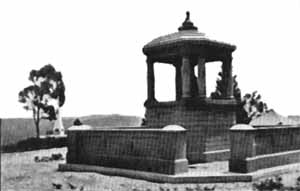THE CENTENARY CELEBRATIONS IN 1913
and the MEMORIAL PAVILION, MOUNT YORK
In August 1912, following a number of preliminary meetings called by the Mount Victoria Progress Association, a Centenary Celebrations Committee representing all parts of the Mountains was formed. Its objective was to initiate without delay a movement to celebrate the centenary of Blaxland, Lawson & Wentworth's crossing of the Mountains. Frank Walker, President of the Australian Historical Society, was elected President, with Blue Mountains notables such as J. W. Berghofer, H. G. Rienits , G. J. Waterhouse and George Davies among the committeemen.
 During the course of the preliminary meetings it had been established that the centenary would be planned as a National celebration, though “the interest and right of Mount York to the demonstration” would be zealously guarded. To arouse public interest Frank Walker wrote a series of articles on The Crossing of the Blue Mountains which were published over three issues of the Blue Mountain Echo (12, 19, 26 July 1912) and, on his election to the presidency of the new committee, expressed his hope that “parochialism would be excluded … and that all would work amicably together for the veneration of the memory of those great men.”
During the course of the preliminary meetings it had been established that the centenary would be planned as a National celebration, though “the interest and right of Mount York to the demonstration” would be zealously guarded. To arouse public interest Frank Walker wrote a series of articles on The Crossing of the Blue Mountains which were published over three issues of the Blue Mountain Echo (12, 19, 26 July 1912) and, on his election to the presidency of the new committee, expressed his hope that “parochialism would be excluded … and that all would work amicably together for the veneration of the memory of those great men.”
Over the next eight months or so the Committee met at different places throughout the Mountains drumming up enthusiasm and funds and, while not untouched by controversy, steered proceedings towards perhaps the most momentous occasion yet staged on the Mountains.
On a clear but cold 28 May 1913 the Governor, Sir Gerald Strickland, travelled up the Mountains to Mount Victoria by train, passing through stations festooned with bunting and flags. On arrival he addressed the massed assembly of school children (which included a choir of 1500 voices) in the park, exhorting them to follow in the footsteps of the explorers and learn from their determination. There were, he said, “many other things to be achieved in life for themselves and their families, their country, and the British race.”
 After lunching in the park at Mount Victoria the dignitaries, who included politicians of all levels of government, prominent citizens and descendants of the three explorers, moved in a cavalcade of cars and other vehicles to the main event – the unveiling and dedication of a Memorial Pavilion (in actual fact, only the base of it which fortunately included the memorial tablet, for wet weather and “other unforseen delays” had prevented its completion on time) at Mount York. The Governor performed this duty to the satisfaction of all present – “deafening cheers rent the air, and the utmost enthusiasm prevailed” – and other dignitaries eulogised the three explorers to the cheers of the crowd. Further inscriptions on the Pavilion honoured the work of Evans, Macquarie and Cox.
After lunching in the park at Mount Victoria the dignitaries, who included politicians of all levels of government, prominent citizens and descendants of the three explorers, moved in a cavalcade of cars and other vehicles to the main event – the unveiling and dedication of a Memorial Pavilion (in actual fact, only the base of it which fortunately included the memorial tablet, for wet weather and “other unforseen delays” had prevented its completion on time) at Mount York. The Governor performed this duty to the satisfaction of all present – “deafening cheers rent the air, and the utmost enthusiasm prevailed” – and other dignitaries eulogised the three explorers to the cheers of the crowd. Further inscriptions on the Pavilion honoured the work of Evans, Macquarie and Cox.
Mount Blaxland, the terminal point of the expedition, was not forgotten though its isolation made it difficult to include it in the day's festivities. The Centenary Committee arranged for a marble tablet inscribed in honour of the three explorers to be erected on its summit and during the official day of celebration an Australian flag “floated out on the breeze, from sunrise to sunset”. Like Mount York it too was, in the words of Frank Walker, recognised as “holy ground”.
I don't know exactly how many people were present in Mount Victoria and Mount York that day, but the photographs suggest a crowd the size of which has not been witnessed since in that, usually quiet, part of the Mountains.
© John Low 2001
